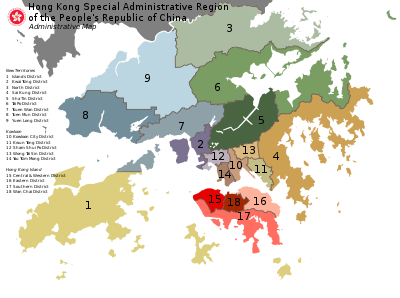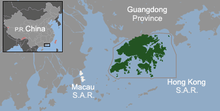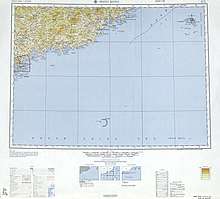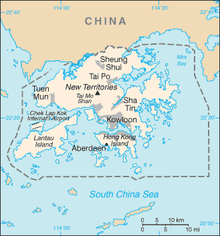Geography of Hong Kong
Hong Kong, a Special Administrative Region of the People's Republic of China, can be geographically divided into three territories: Kowloon, Hong Kong Island, and the New Territories. Hong Kong is a coastal city and major port in Southern China, bordering Guangdong province through city of Shenzhen to the north and the South China Sea to the West, East and South. Hong Kong and its 260 territorial islands and peninsulas are located at the mouth of the Pearl River Delta. The area of Hong Kong is distinct from Mainland China, but is considered part of "Greater China".

Hong Kong has a total area of 1,108 km2 (428 sq mi), of which 3.16% is water. 60 islands are dispersed around Hong Kong, the largest of which by area is Lantau Island, located Southwest of the main peninsula. Lantau Island and the majority of the remaining islands are part of the New Territories, an area that also encompasses the hilly terrain north of Kowloon. Hong Kong Island is separated from Kowloon by Victoria Harbour, a natural landform harbour. The Kowloon Peninsula to the south of Boundary Street and the New Territories to the north of Hong Kong Island were added to Colonial Hong Kong in 1860 and 1898, respectively.
Further from Victoria Harbour and the coast, the landscape of Hong Kong is fairly hilly to mountainous with steep slopes. The highest point in the territory is Tai Mo Shan, at a height of 958 metres in the New Territories.[1] Lowlands exist in the northwestern part of the New Territories. Portions of land in the New Territories and Hong Kong island are reserved as country parks and nature reserves.
With the fourth highest population density of countries and dependencies in the world at 6,300 people per square kilometer, Hong Kong is known for its shortage of residential space. Hong Kong has undergone several land reclamation projects to provide more space for residential and economical purposes, increasing its land area. This has caused the distance between Hong Kong Island and Kowloon to decrease. Hong Kong International Airport is the sole public airport in the territory, and is mostly located on reclaimed land on the island of Chep Lap Kok.
Politically, Hong Kong is divided into 18 districts, each having a district council. Nevertheless, most public services operate across the territory, and travel between the districts is not restricted. Sha Tin is the most populous district as of 2019.
The name "Hong Kong", literally meaning "fragrant harbour", is derived from the area around present-day Aberdeen on Hong Kong Island, where fragrant wood products and incense were once traded.[2] The narrow body of water separating Hong Kong Island and Kowloon Peninsula, Victoria Harbour, is one of the deepest natural maritime ports in the world.
Hong Kong is 60 km (37 mi) east of Macau, on the opposite side of the Pearl River estuary. Hong Kong and Macau are connected through the Hong Kong–Zhuhai–Macau Bridge.
Climate
Hong Kong's climate is subtropical and monsoonal with cool dry winters and hot and wet summers. As of 2006, its annual average rainfall is 2,214 mm (87.2 in), though about 80% of the rain falls between May and September. It is occasionally affected by tropical cyclones between May and November, most often from July to September. The mean temperature of Hong Kong ranges from 16 °C (60.8 °F) in January and February to 28 °C (82.4 °F) in July and August.[3]
January and February are more cloudy, with occasional cold fronts followed by dry northerly winds. It is not uncommon for temperatures to drop below 10 °C (50 °F) in urban areas. Sub-zero temperatures and frost occur at times on high ground and in the New Territories. March and April can be pleasant although there are occasional spells of high humidity. Fog and drizzle are common on high ground which is exposed to the southeast. May to August are hot and humid with occasional shower and thunderstorms. Afternoon temperatures often exceed 31 °C (87.8 °F) whereas at night, temperatures generally remain around 26 °C (78.8 °F) with high humidity. In November and December there are pleasant breezes, plenty of sunshine and comfortable temperatures.[4]
Geographical information
Location





Hong Kong is on China's southern coast, 60 km (37 mi) east of Macau, on the east side of the mouth of the Pearl River estuary. It is surrounded by the South China Sea on all sides except the north, which neighbours the Guangdong city of Shenzhen along the Sham Chun River. The territory's 2,755 km2 (1,064 sq mi) area consists of Hong Kong Island, the Kowloon Peninsula, the New Territories, Lantau Island, and over 200 other islands. Of the total area, 1,073 km2 (414 sq mi) is land and 35 km2 (14 sq mi) is water.[5] The territory's highest point is Tai Mo Shan, 957 metres (3,140 ft) above sea level.[6] Urban development is concentrated on the Kowloon Peninsula, Hong Kong Island, and in new towns throughout the New Territories.[7] Much of this is built on reclaimed land, due to the lack of developable flat land; 70 km2 (27 sq mi) (six per cent of the total land or about 25 per cent of developed space in the territory) is reclaimed from the sea.[8]
Undeveloped terrain is hilly to mountainous, with very little flat land, and consists mostly of grassland, woodland, shrubland, or farmland.[9][10] About 40 per cent of the remaining land area are country parks and nature reserves.[11] The territory has a diverse ecosystem; over 3,000 species of vascular plants occur in the region (300 of which are native to Hong Kong), and thousands of insect, avian, and marine species.[12][13]
Land boundaries
Total: 30 km (19 mi)
Border city: Shenzhen Special Economic Zone, Guangdong Province
Figures published by the United States Central Intelligence Agency[1]
Coastline
Total: 733 km (455 mi)
Maritime claims:
Territorial sea: 3 nautical miles (5.6 km; 3.5 mi)
Figures published by the United States Central Intelligence Agency[1]
Islands
Hong Kong has 263 islands over 500 m2 (5,400 sq ft),[14] including Hong Kong Island, Lantau Island, Cheung Chau, Lamma Island, Peng Chau and Tsing Yi Island.
Terrain
Hong Kong's terrain is hilly and mountainous with steep slopes. There are lowlands in the northern part of Hong Kong. A significant amount of land in Hong Kong, especially on the Hong Kong Island and the Kowloon peninsula, is reclaimed.
Extreme points
The lowest elevation in Hong Kong is in South China Sea (0 m) while the highest elevation is at Tai Mo Shan (957 m (3,140 ft)) in Tsuen Wan, the New Territories.
Land
- Northernmost: Shenzhen River 22°33′44″N 114°9′41″E
- Easternmost: Ping Chau 22°32′26″N 114°26′30″E
- Southernmost: Tau Lo Chau 22°9′14″N 113°55′21″E
- Westernmost: Peaked Hill 22°13′1″N 113°50′7″E
Principal peaks of Hong Kong
- Tai Mo Shan - 957 m (3,140 ft), Tsuen Wan
- Lantau Peak (Fung Wong Shan) - 934 m (3,064 ft) on Lantau Island
- Sunset Peak (Tai Tung Shan) - 869 m (2,851 ft), on Lantau Island
- Sze Fong Shan - 785 m (2,575 ft)
- Lin Fa Shan - 766 m (2,513 ft), on Lantau Island
- Nei Lak Shan - 751 m (2,464 ft), on Lantau Island
- Yi Tung Shan - 747 m (2,451 ft), on Lantau Island
- Ma On Shan - 702 m (2,303 ft)
- The Hunch Backs (Ngau Ngak Shan) - 674 m (2,211 ft)
- Grassy Hill - 647 m (2,123 ft)
- Wong Leng - 639 m (2,096 ft)
- Buffalo Hill - 606 m (1,988 ft)
- West Buffalo Hill - 604 m (1,982 ft)
- Kowloon Peak (Fei Ngo Shan) - 602 m (1,975 ft)
- Shun Yeung Fung - 591 m (1,939 ft)
- Tiu Shau Ngam - 588 m (1,929 ft)
- Kai Kung Leng - 585 m (1,919 ft)
- Castle Peak - 583 m (1,913 ft)
- Lin Fa Shan, Tsuen Wan - 578 m (1,896 ft)
- Tate's Cairn (Tai Lo Shan) - 577 m (1,893 ft)
Victoria Peak, the highest point on Hong Kong Island, at 552 m (1,811 ft) is the 24th highest peak in Hong Kong.
Natural resources
The natural resources of Hong Kong can be divided into three main categories:
- Metalliferous minerals and non-metalliferous industrial minerals in the onshore area;
- Quarried rock and building stone;
- Offshore sand deposits.
Despite its small size, Hong Kong has a relatively large number of mineral occurrences. Some mineral deposits have been exploited commercially. Metalliferous mineral occurrences are grouped into four broad categories: tin-tungsten-molybdenum mineralisation, copper-lead-zinc mineralisation, iron mineralisation and placer deposits of tin and gold. Mesozoic igneous activity is largely responsible for this diversity of mineral deposits and the mineral concentrations have been variably enhanced by hydrothermal activity associated with faulting. Concentrations of non-metalliferous minerals that have been commercially exploited include kaolin clay, feldspar, quartz, beryl and graphite.[15]
For many years, granite and volcanic rocks have been quarried locally for road base metal, riprap, armour stone and asphalt, although the main purpose now is for concrete aggregates. At present, there are three quarries operating in Hong Kong. These are principally in granite and are located at Lam Tei, Shek O and Anderson Road. All the quarries are in the process of rehabilitation and have a life expectancy of between two and eight years.[15]
Offshore sand bodies have been dredged for aggregate sand and reclamation fill in Hong Kong as the rate of urban development has increased.[16]
Additional natural resources include forest and wildlife.
Land use
Arable land: 2.95%
Permanent crops: 0.95%
Other: 96.10% (2012 est.)
Figures published by the United States Central Intelligence Agency[1]
Big 22
Natural hazards
Tropical cyclones are frequent in Hong Kong during the summer months between June and August. Landslides are common after rainstorms.
Environmental issues
- Air and water pollution from rapid urbanisation
- Extinction of natural species
- Introduction of exotic species
See also
References
- "Hong Kong" Archived 3 May 2009 at the Wayback Machine. The World Factbook. CIA. Retrieved 18 September 2009.
- Visit Hong Kong: Volume 1, Spring, 2004 (p.14) Archived 7 December 2006 at the Wayback Machine, University of Hong Kong English Centre.
- Hong Kong Survey & Mapping Office, Lands Department. Hong Kong Guide 2007 [map]. Notes on Hong Kong, p. 411. ISBN 962-567-174-9.
- Climate of Hong Kong Archived 17 October 2016 at the Wayback Machine Hong Kong Observatory. Retrieved on 1 September 2007.
- Citation error. See inline comment how to fix.
- Citation error. See inline comment how to fix.
- Citation error. See inline comment how to fix.
- Citation error. See inline comment how to fix.
- Citation error. See inline comment how to fix.
- Citation error. See inline comment how to fix.
- Citation error. See inline comment how to fix.
- Citation error. See inline comment how to fix.
- Citation error. See inline comment how to fix.
- Lands Department (February 2011), Hong Kong Geographic Data (PDF), archived (PDF) from the original on 5 March 2012, retrieved 29 April 2011
- R.J. Sewell; S.D.G. Campbell; C.J.N. Fletcher; K.W. Lai; P.A. Kirk (2000). The Pre-Quaternary Geology of Hong Kong. Government of Hong Kong SAR. ISBN 962-02-0299-6.
- J.A. Fyfe, R.Shaw, S.D.G. Campbell, K.W. Lai & P.A. Kirk (2000). The Quaternary Geology of Hong Kong. Government of Hong Kong SAR. ISBN 962-02-0298-8.CS1 maint: multiple names: authors list (link)
External links
- Climate of Hong Kong
- The Lands Department of the Government of Hong Kong
- "Hong Kong in Figures 2006 Edition",
- "Hong Kong Map"
- Census and Statistics Department, HKSAR. February 2006.
